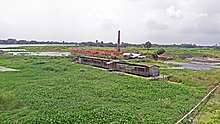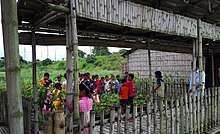Arcadia Education Centre
The Arcadia Education Centre (School) is located in South Kanarchor, Bangladesh[1] on the bank of the Dhaleshwari River.[2] The modular, amphibious structure adapts to seasonal flooding using an innovative design based on traditional building techniques and incorporating local materials.[2][3] The facility contains a preschool, hostel, nursery, and vocational training centre.[4]

Amphibious Architecture
The Maleka Welfare Trust purchased a patch of land so they could relocate one of their preschools and add additional social facilities.[5] The land is flooded five months of the year[1] and its topography is incompatible with conventional solutions to this challenge.[2]

Architect Saif Ul Haque Sthapati of Dhaka, Bangladesh[6] designed a buoyant platform that floats tethered during the rainy season and settles back to the ground during the dry season, allowing the facility to remain operational year-round.[2] In addition to this cost-effective solution to flooding, the building is made of inexpensive materials including several local bamboo varieties and upcycled materials such as steel drums and car tires.[2] The building materials and techniques are based on traditional house construction techniques used in the area.[2] This amphibious structure that rises with water levels could be the potential solution to rising sea levels because of climate change.[7]
The structure is open to nature, allowing students to benefit from natural light while learning from their surroundings.[2]
Maleka Welfare Trust
The Maleka Welfare Trust is a private social welfare organization.[5] Their programs include preschools, a vocational training centre, a nursery, and a hostel for single women.[5]
The Aga Khan Award for Architecture announced the Maleka Welfare Trust's Arcadia Education Project as one of the 2019 Award winners[1][8] for its thoughtful response to flooding using local materials and traditional building techniques.[2][9] Razia Alam was presented the Aga Khan Award for Architecture by His Highness the Aga Khan and Mintimer Shaimiev, State Counselor of the Republic of Tatarstan on September 13, 2019.[10]

Bangladesh is consistently ranked among the countries most at risk from climate change.[11] Each year, massive rainfall causes loss of life and displacement of people.[12][13] Affordable and locally sustainable architectural models like the Arcadia facility improves the everyday lives of Bangladeshis and other affected populations.[2]
References
- McGuigan, Cathleen (August 29, 2019). "The Winners of the 2019 Aga Khan Award for Architecture". Architectural Record. Retrieved 2019-08-30.
- "Arcadia Education Project | Aga Khan Development Network". www.akdn.org. Retrieved 2019-08-28.
- "Saif Ul Haque Sthapati Arcadia Education Project in South Kanarchor Bangladesh | Floornature". Floornature.com (in Italian). Retrieved 2020-04-29.
- "Aga Khan Award: 2 Bangladeshi projects shortlisted". The Daily Star. 2019-04-26. Retrieved 2019-08-28.
- "Shortlist for the 2019 Aga Khan Award for Architecture announced". Architectural Digest Middle East. Retrieved 2019-08-28.
- GmbH, BauNetz Media (2019-05-06). "Von Kinderdorf bis Fischmarkt - Shortlist des Aga Khan Award 2019". BauNetz (in German). Retrieved 2019-08-28.
- "This 'waterproof' bamboo school in Bangladesh could be the solution to rising sea levels due to climate change". India Today. Ist. Retrieved 2019-09-03.
- Woodyatt, Amy (2019-08-29). "Winners of prestigious Aga Khan architecture award announced". CNN Style. Retrieved 2019-08-31.
- "Arcadia Education Project in Bangladesh wins Aga Khan Architecture Award". Jagranjosh.com. 2019-11-26. Retrieved 2019-11-26.
- "International experts praise Bangladesh's excellence in architecture". unb.com.bd. Retrieved 2019-09-20.
- "Bangladesh, India Most Threatened by Climate Change, Risk Study Finds | National Geographic (blogs)". 2016-05-03. Archived from the original on 2016-05-03. Retrieved 2019-08-28.
- "GLOBAL CLIMATE RISK INDEX 2019" (PDF). German Watch. December 2018.
- "Wayback Machine" (PDF). 2017-09-25. Archived from the original (PDF) on 2017-09-25. Retrieved 2019-08-29.